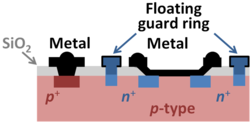User:John R. Brews/Draft: Difference between revisions
Jump to navigation
Jump to search
imported>John R. Brews No edit summary |
imported>John R. Brews No edit summary |
||
| Line 1: | Line 1: | ||
{{Image| | {{Image|Planar Schottky diode.PNG|right|250px|Planar Schottky diode with ''n<sup>+</sup>''-guard ring and tapered oxide.}} | ||
{{TOC|right}} | {{TOC|right}} | ||
==Schottky diode== | ==Schottky diode== | ||
Revision as of 12:30, 29 January 2011
Schottky diode
The Schottky diode is a two-terminal device consisting of conductive gate (for example, a metal) on top of a semiconductor body. A generic name for this structure is the metal-semiconductor diode or M/S diode.[1] For low voltage applications, below 200V, silicon is used, but for higher voltages (up to 3000 V or more) silicon carbide is used to extend the breakdown voltage. These voltages are achievable only when edge breakdown is avoided, which requires special attention to edge termination designs.[2]
Notes
- ↑ The term "Schottky diode" may be taken erroneously to refer to diffusion as the mechanism of operation as first proposed by Mott, Schottky and Davydov. However, the mechanism in most devices is thermionic emission, as later proposed by Bethe. See Chih-Tang Sah (1991). “§560: Metal/semiconductor diode”, Fundamentals of solid-state electronics. World Scientific, p. 474. ISBN 9810206372.
- ↑ B. Jayant Baliga (2005). “§3.2 Schottky diode edge terminations”, Silicon carbide power devices. World Scientific. ISBN 9812566058.
http://books.google.com/books?id=FPlJQ0iO7oQC&pg=PA134&dq="Schottky+diode"&hl=en&ei=iAg6TeO7AYSasAOk67WhAw&sa=X&oi=book_result&ct=result&resnum=8&ved=0CGIQ6AEwBw#v=onepage&q="Schottky diode"&f=false
